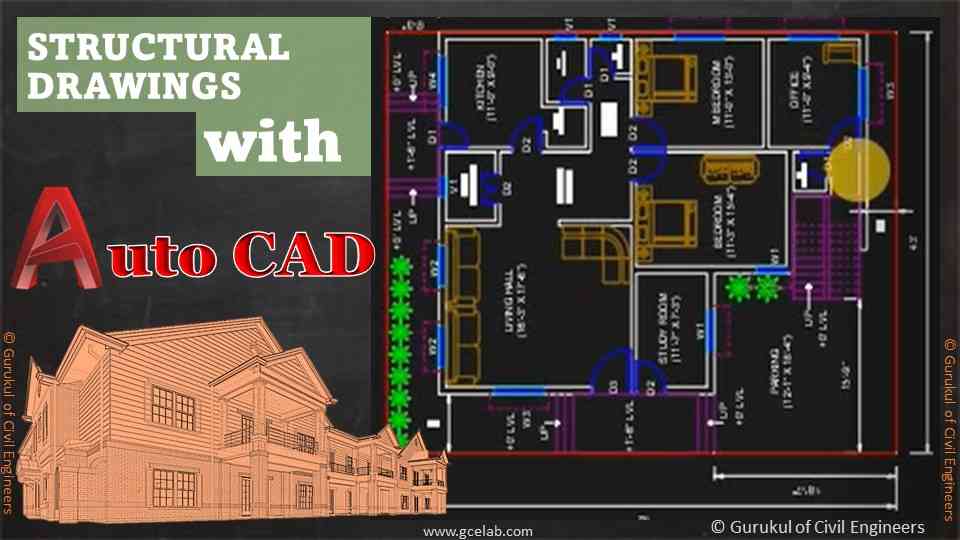How to Prepare a Structural Drawing?
- By
- Pooja |
- January 18, 2022 |
- Civil Engineering, AutoCAD Drawings, Bridge Engineering, Building/ Structure Engineering,

What is in a Structural Drawing?
The Layout of Roof Beams and Shutters
How to prepare structural drawings?
How do you read a structural drawing?
What are the types of structural plans?
How do you read a structural steel beam size?
What is RCC working drawing used for?
What is BIM Structural drawing?
What is a Structural Drawing?
A structural drawing is a series of plans that depicts the construction of a building structure. It contains foundation and dimension information, framing details, Bracing systems, beam and column details, and wall sections, all of which are utilized to guide the construction of the structure.
Types of Structural Drawings?
Structural Drawing
This type of design drawing shows how beams, columns, staircases, slabs, and other structural elements are connected, as well as the “strength of different structural elements, structural materials, grade, size, and placement of reinforcement, and the strength of the building.
General Note
A general note is a draught that incorporates codes, bylaws, and structural drawing specifics such as concrete mix, lapping length, curing time, abbreviation, mapping forms, building type, legends, and other work methods.
Drawing for Excavation
The excavation of footing dimension, position of the column, footing plan layout, and column grid lines are all shown on the excavation drawing. This illustration depicts the scope of excavation, such as soil removal, as well as the excavation process, which includes trenching, wall shafts, tunnelling, and other techniques.
Column Layout
The design and configuration of the columns throughout the structure are reinforced by the column layout. This plan divides the building into floors and specifies the precise size and distance between each column. Contractors will be able to study the entire building layout with the help of column plan layout drawings.
Beam Layout
Plinths are used to reinforce a building's support structure. The plinth beam layout platform, length and design of the plinth are made floor-wise.
The layout of Lintel Beam
Another type of beam structure is the lintel beam, which is used to add strength to the area of the building above the door and windows. The exact placements, size, and a number of beam lintels on each floor are included in this type of picture.
The Layout of Roof Beams and Shutters
The roof beam is used to strengthen the overall structure of the building. It is the triangular structure that sustains the roof and is normally built on top of the building. These are normally built of wood, but they can also be made of steel or concrete.
The Layout of Roof Slabs
Room slab layout is provided to complete an account of the roof faces, floors, & other surfaces that require accurate edge information, as the name implies. In the AutoCAD software, this is made more significantly.
How to prepare structural drawings?
The final stage of a structural design is the creation of a Structural Drawing. The structural drawing or structural plan is made up of structural elements as well as a basic arrangement building plan or building layout for the site.
All of the intricacies that we need to follow throughout site construction are portrayed in these designs. Although it is the responsibility of the structural draughtsman to prepare the Structural Drawing, the onus lies on the Structural Designer to ensure that the right drawing standard is followed and executed. We all know that every simple or complex detail of our design must be correctly reflected in the drawing.
How do you read a structural drawing?
Structural drawing, which is a form of engineering drawing, is a design or set of plans and details for the construction of a building or other structure. Plans, Elevations, X-Sections, General Notes and Details are among the subsets of the structural drawings collection.
What are the types of structural plans?
- Site Plan
- Floor Plan
- Cross Section
- Elevation
- Landscape
- Finishing Drawing
- Working Plan
- Section Drawings
How do you read a structural steel beam size?
The W denotes a wide flange beam (as opposed to, say, an S beam); the 14 denotes the section number, and the 211 denotes the beam's weight per foot of 211 lbs. It's worth noting that, depending on the beam size, allowed deviations from the required specifications can range from 1/8 into 5/16in”.
Read More:
What is the Function of Bridge Foundation or Pier and its Types? 5 Important Points
Pre-stressed Concrete, Pre-tensioning and Post-tensioning: 3 Important Points
What is RCC working drawing used for?
Drawings for Architecture
The architectural drawing serves as the mother drawing for all other construction drawings. It includes all the project details such as site plan, elevations, setting out plan, standard details, sections and other details.
Working Plan
This drawing depicts the building's horizontal measurements, wall thickness, clear areas inside the structure, and column positions. It also illustrates the required openings within the structure, such as windows, doors, and ventilators.
Section Diagrams
Section drawings exhibit the construction material, depth, types and measurements of various building components, and the types of structural components such as slab type, among other things. It depicts the drawing of a building that has been chopped via a vertical plane.
Drawing of Elevation
The information on openings, the size and shape of the exterior surface, the height of the building, and the finish of the building after completion are all represented on an elevation drawing. These sketches are created by looking at the architecture from an aesthetic standpoint.
Electrical Schematics
Electrical drawings show the placement and features of electrical wiring, fittings, substations, and switches, among other things. The drawing also contains an electrical load calculation, an electrical legend, a floor power plan, a floor lighting plan, a single line diagram, a fire alarm layout, a CCTV camera, as well as an equivalency table, lightning protection, and earth data.
Drawings for Plumbing
On each floor, the plumbing construction plan shows the markings and locations of plumbing components such as sanitary, water supply piping, fixtures, equipment, pumps, pipes, drains, taps, and outlets. This encompasses everything from the type and size of sinks to gas location and the process of connecting all of the fixtures.
What is BIM Structural drawing?
BIM is a process that involves the creation and administration of a digital model that aids in the design, construction, and maintenance of a structure during its entire existence. The purpose of BIM is to create buildings that are well-designed, efficient, cost-effective, and environmentally friendly.
I hope the blog provides you with a sound understanding of the Structure Drawings and their production procedure.
Please feel free to like, share and comment.
Admin, gcelab.com
Please see our Pillar Post to know why we founded gcelab.com.
Read More:
Why does Concrete need Reinforcement? 6 Important Points
Column Layout for Residential Building - 4 Important Points
What is the purpose of Structure Engineering Software?

Pooja
Founder at gcelab.com, Pooja is an Entrepreneur unlocking human potential. Working in the Principles of Lean Start-up, Pooja believes in Transparency and User Happiness the most. Pooja’s background in teaching gives her a sophisticated grasp on even the most tedious aspect of course building. She is passionate about people who believe that good is not enough.
Next Post



